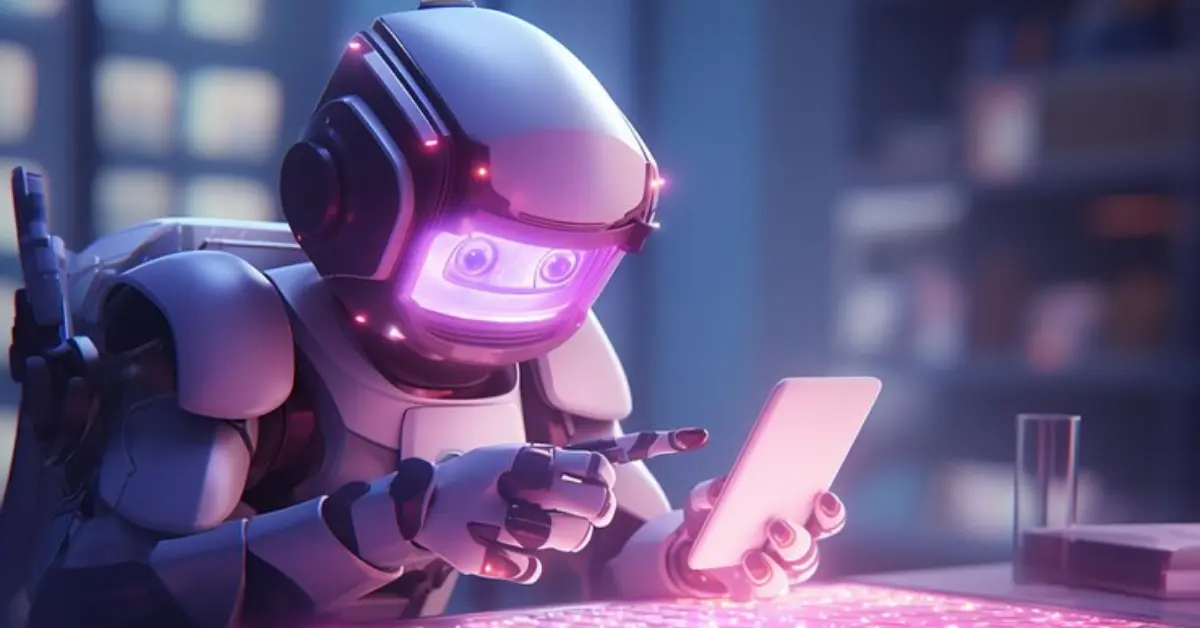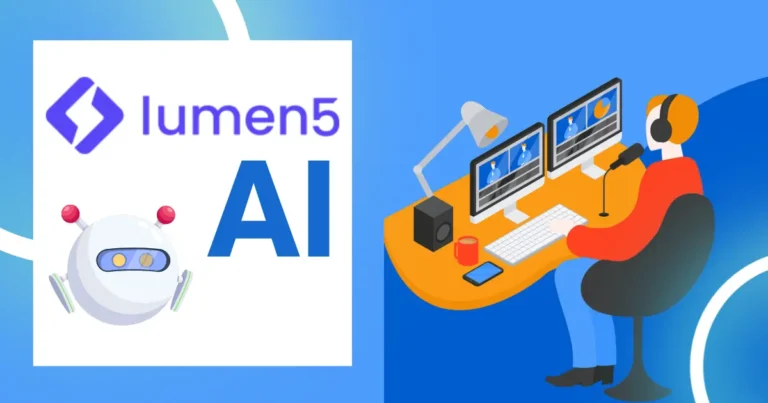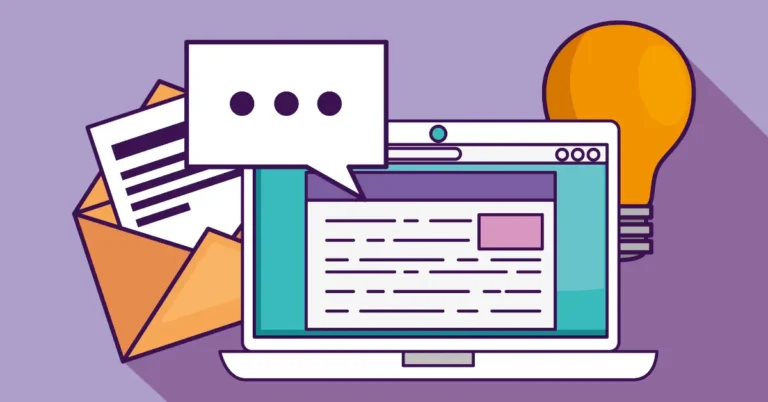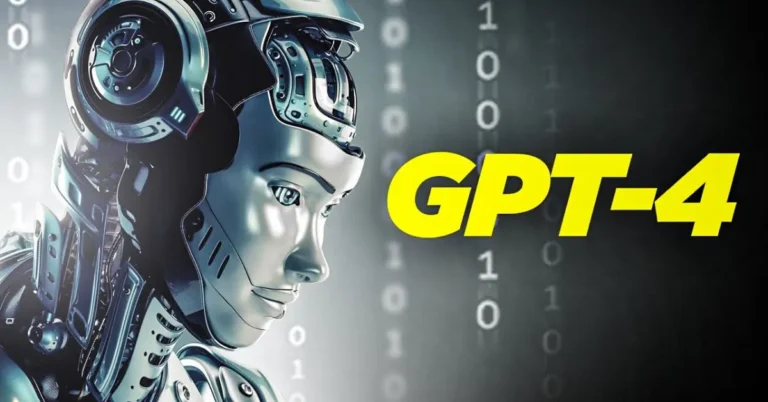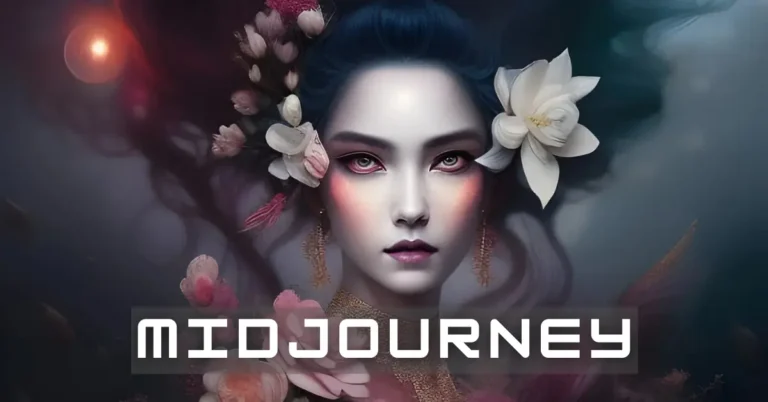10 Best AI Chatbots Online with Super AI Capabilities | Chat GPT AI Chatbot, Microsoft AI Chatbot, Bing Chatbot, Google AI Chatbot, & More
Last Updated on July 9, 2024 by Sagar Sharma
AI chatbot online: Many may think that online chatbots are new to the world. The truth is, they have spent some time with humans and grown with us. Believe it or not, Chatbots are almost 60 years old now. While many humans forget their first name by this age, chatbots have become quicker and smarter than most humans. AI chatbot online that we interact with today have evolved in three major stages, namely: basic chatbots, conversational agents, and generative AI chatbots.
Online AI Chatbots: A Brief History
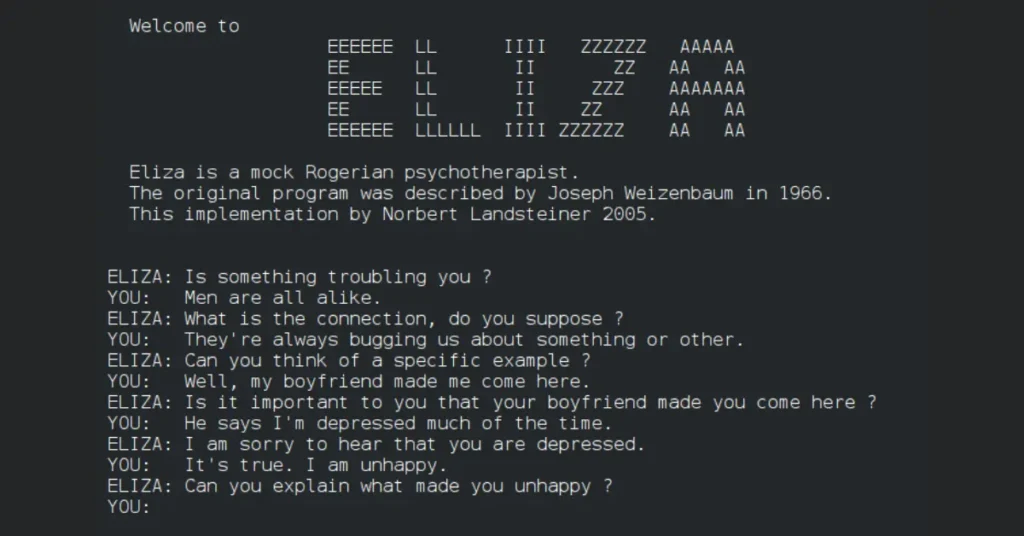
Basic Chatbots – These were the early stage chatbots that relied solely on decision trees & keyword recognition. Decision trees helped to solve user queries on the basis of the large training data. Example of decision tree in case of troubleshooting a tech problem:
Bot: Does your PC turn on?
Person: No
Bot: Is it plugged in?
Person: No
Bot: Plug in the cable to turn on your PC.
————————————–
Bot: Does your PC turn on?
Person: Yes
Bot: Great! Let me know if you have any questions.
Basic chatbots are still prevalent in some areas such as contact centers where chatbots are deployed to resolve basic user queries. Similarly, keyword recognition is used to understand specific words and phrases for decision-making. For instance, if you’re chatting with a weather chatbot and ask “What is the weather like today in New York?”, the chatbot recognizes the keywords “weather”, “today”, and “New York”. Keyword recognition continues to help Chatbots figure out what the human is asking for and respond appropriately.
Some common basic chatbots were: ELIZA, A.L.I.C.E, and SmarterChild.
Conversational Agents – Advancing further, conversational agents are the kind of online chatbots that are capable of understanding the human language even better. These chatbots use natural language processing and machine learning to hold better conversations and provide accurate solutions to user queries. These chatbots are able to process voice commands, recall past conversations, and more.
Some common examples of conversational agents are: IBM Watson, Alexa, and Siri.
Generative AI Chatbots – These are the AI chatbots that we are currently using such as ChatGPT. As AI expanded its roots around the world, machine learning models were being trained on massive datasets of knowledge. This process caused the creation of generative AI chatbots. These chatbots were developed with the aim of being as human-like as possible.
Experts taught the machines to behave, think, and process queries like a human would, and be more imaginative. Believe it or not, AI read a lot of books, websites, and everything on the internet to be “more human”. Generative AI chatbots do not follow any set of rules, these chatbots use their own imagination and the large training data to provide the most accurate and human-like solutions. These AI chatbots can write articles, summarize a thesis, create images, write social media captions, respond to your customer’s queries like an actual person, and much more.
Some common examples of generative AI Chatbots are: ChatGPT, Jasper AI, Midjourney AI, Google Bard, etc.
Also Read: ChatPDF AI: Chat with Any PDF Online for Free
10 Best AI Chatbots online
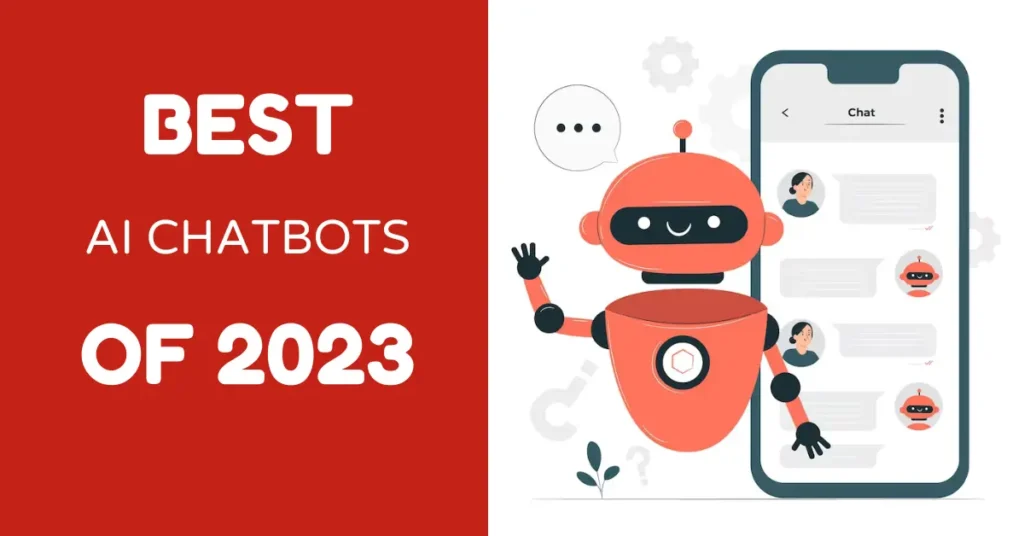
Honestly, to ease up a load of looking for the best AI Chatbots in 2023, our head writer and a lazy panda @Sagar took the easier road and cleverly asked ChatGPT “Which are the best free online chatbots”. Quite predictably, ChatGPT gave itself the award for the “best AI chatbot of the century”. “You are hallucinating again GPT! (there is a sense of acquiescence)
Since we can not completely rely on AI, we had to have a word with the OG treasures of anything and everything – Google/Bing and found that today there are a number of free-to-use online chatbots, other than ChatGPT or Bard that can make our lives easier. Here are the best AI chatbot online in 2023.
1. Chat GPT AI Chatbot

Top Features: Natural Language Understanding | Language Translation | Content Generation | Coding | General Question Answering | GPT-4 | No Prompt Limitations |
We guess ChatGPT was right about itself. Love it or hate it, you definitely cannot ignore it. Although a gigantic number of AI chatbots have come into existence ever since the launch of Openai ChatGPT in 2022, Open AI proudly retains the winning title.
Also Read: GPT-4 Features: Benefits and Limitations of GPT-4 Model
ChatGPT is an online ai chatbot that can produce text based on your written prompts. You can use it to generate long-form as well as short-form content and also use it for any general or technical queries. It has also served as a great ai tool for students and working professionals. You can ask it any type of questions, get explanations of complex topics, use it to translate any piece of text into your desired language, etc. GPT 3.5 is capable of generating both long-form such as articles and blog posts and short-form content such as emails, ad copy, social media captions, and more with no prompt limitations.
During the initial phase users of Chat GPT chatbot faced a lot of challenges while trying to access the online chatbot due to the enormous demand. However, the company has managed to get past that and provide a seamless user experience.
GPT chat bot was officially released on November 30, 2022, and has since garnered over 100 million users globally. On March 14, 2023, Open AI released the upgraded version – GPT-4 with upscaled performance, reliability, and interesting features such as the ability to read images. So far GPT 3.5 and GPT-4 have been deployed by numerous organizations and are used by millions for their daily requirements. So in case you have not tried it yet, you can use ChatGPT for free at chat.openai.com
Also Read: Top AI Trip Planners & ChatGPT Apps of 2023
2. Microsoft AI Chatbot – Bing AI (The New Bing AI)
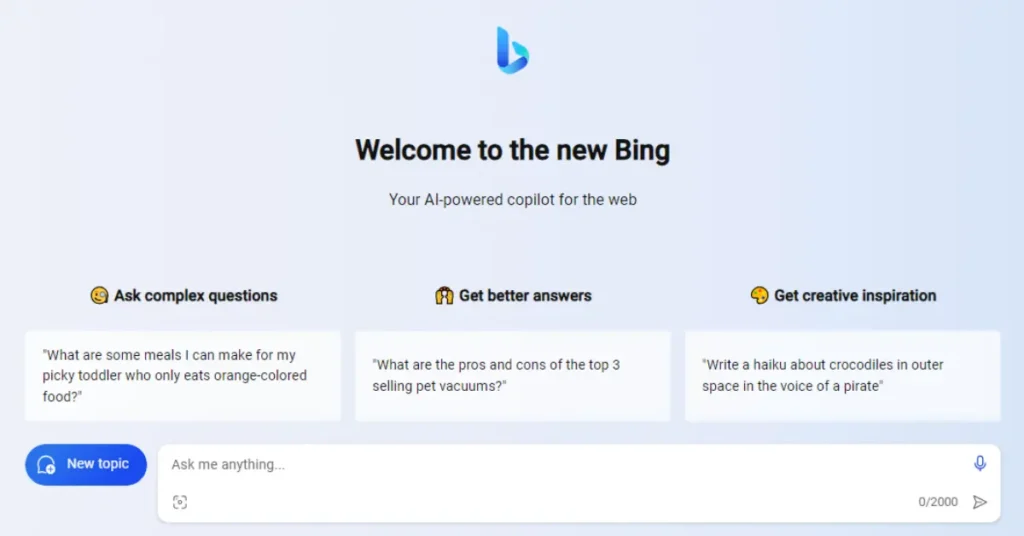
Top Features: General Question Answering | GPT-4 | Access to internet | Source Citation
In February 2023, Microsoft announced the all-new Bing AI chat (new Bing) in collaboration with Open AI’s ChatGPT. The new Bing runs on GPT-4, the more accurate and advanced version of Open AI’s natural language model. The Microsoft AI Chatbot (Bing Chatbot) can be used as a search engine to look up answers, and also for content generation such as poems, stories, code, essays, songs, celebrity parodies, and more.
The biggest USP of Microsoft Bing AI is that it has access to the internet. Meaning that it can search the web for you and provide answers based on the latest information it finds through the Bing search engine. Users can then easily copy the responses or export them as a Word, PDF, or text document.
Bing AI chat provides the answer to the user queries in short and concise paragraph(s), eliminating the need to go through the whole SERP. Bing also includes links to the source websites from where it found the information.
Alternatively, you can also add an image as a prompt and it will analyze the visual and text of the image to understand what you could be referring to.
The Microsoft AI chatbot is available in light and dark themes.
3. Perplexity AI

Top Features: Research | Source Citations | Copilot Search | Claude-2/GPT-4
Perplexity AI is an online ai chatbot that can be used to do intensive research in seconds. Just like the Microsoft Bing AI chatbot, perplexity AI also goes through the deepest corners of the internet to present you with the most accurate and to-the-point information.
Using perplexity is as simple as black and white. You just visit the online chatbot and start typing your prompt. Perplexity will provide detailed answers to your queries along with citations of source websites. However, you need to log in to use Copilot or view/save threads.
The results often include images that are also fetched from the same sources. Underneath any answer, you will also get a set of related questions for further exploration and clarification. These related questions are generated to encourage deeper engagement and to assist users in obtaining more detailed information or context on the topic they are inquiring about.
As an online ai chatbot, perplexity has a 20-question limit, but that’s per session. Users can have 10 sessions daily. Alongside, users also get 5 free copilot searches that reload every 4 hours. When on copilot, perplexity provides better guidance to the users around their queries through follow-up questions. Perplexity copilot also understands user queries better and performs multiple searches to provide more interactive and personalized answers.
The perplexity pro version offers Claude 2/GPT-4 support to provide an even more intense lookup on your queries, 300+ copilot uses, unlimited file upload, and pro support.
Also Read: Smart Tips to Create Midjourney Images without Text
4. Google AI Chatbot – Google Bard

Top Features: PaLM-2 Model | Content Generation
Google was one of the first adopters of generative AI. After the massive success of ChatGPT and Microsoft Bing, Google announced the Bard chatbot. The popular online chatbot is Google’s experimental, conversational AI chat service. Bard utilizes Palm-2 (Pathways Language Model) – a language model developed by Google itself. Google uses the same language model to incorporate AI into its other products such as Google Docs, Gmail, and Google Sheets.
The paLM 2 model used in the Google Bard AI chatbot uses a new technique known as compute-optimal scaling to produce better results with fewer parameters and a smaller training dataset.
Through Google Bard users can create various forms of content, summarize text, and translate languages as well as work around creative tasks such as writing stories and poems. Though PaLM 2 is known for its improved coding capacities, users have not had the best experience of using Google Bard for coding purposes.
5. Jasper AI Chatbot

Top Features: Marketing Content | 50+ Templates | GPT-3 API | Source Citations | Add to chrome | Grammar/Plagiarism Checker
Jasper AI is an interesting AI Chatbot that can be used to create multiple forms of marketing content including blogs, reviews, ad copy, sales emails, etc. Users can choose from 50+ templates all set to be used for various requirements. The reason Jasper is here on this list is because of the huge number of features it offers to its users.
Jasper is built on the GPT-3 API. But unlike ChatGPT, Jasper AI chatbot is up to date with its information and also cites sources in responses. It is great for social media and marketing campaigns, can produce content that matches the tone of your brand, can quickly check for grammar and plagiarism issues, etc.
Another advantage of using Jasper is that it can be added to Chrome or Edge for use across apps like Gmail, WordPress, LinkedIn, etc.
Jasper also offers features such as text and image AI generation, document sharing, and multi-user login. One must-mention feature on Jasper AI is “Explain it to be like a 5th grader“. A feature which, well does what it says – explains complex concepts or text with tons of jargon to you in the easiest, most digestible form.
Since the brand is offering so much to its customers, Jasper AI isn’t free. The popular AI chatbot is available for a starting price of $49/mo or $468/year (20% off). The team’s plan is available for $125/mo or $1188/year (20% off). You can however start a free plan for 7 days and decide for yourself. An additional 20% discount is available for non-profit organizations.
6. Chatsonic by Writesonic
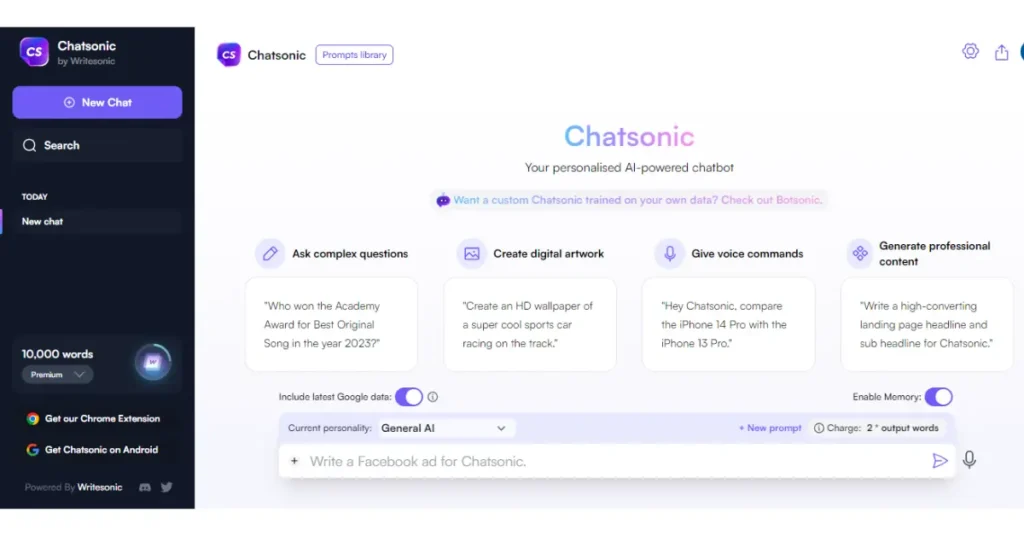
Top Features: GPT-4 | Real time google search | Citations | AI Image Generation | Voice Dictation
If you feel more interested in the Chatbots that live in the present time and are aware of the latest events, then Chatsonic is the best AI chatbot for you. Powered by Open AI’s GPT-4 and supported by Google, Chatsonic can do a lot for content creators.
Chatsonic also adds footnotes with links/citations of the website(s) it fetched the knowledge from so that you can verify the credibility of the information.
Calling itself the “best free ChatGPT alternative”, Chatsonic has tried to win everywhere that ChatGPT lacks.
Apart from written content, Chatsonic can also generate beautiful AI images based on user prompts. If you feel too tired to type, simply speak to the AI and it will use voice dictation to understand your voice and take it as a prompt.
Chatsonic is available for a price of $13/Mo or goes up to $1749/Mo depending on the words you require. You can try Chatsonic for free and enjoy up to 2500 words.
7. Copy AI Chat

Top Features: GPT-3 LLM | Online Marketing | Email Campaigns | Scripts | Blog Templates
Copy AI Chat is one of the best AI chatbot online available online. Based on the GPT model, copy AI offers multiple features in one place.
Apart from blog writing, Copy AI can be used to generate high-converting email campaigns in just a few clicks, social media posts: YouTube descriptions, TikTok scripts, Instagram captions, LinkedIn posts, and content translations.
Copy AI has a number of tools for various purposes such as website copy, and startup tools. blog tools, sales copy, brainstorming tools, etc. Other than these, there are some premium tools such as: passive to active voice, explain like i am 5, bullet points to paragraph, two sentence stories, etc.
Using these tools, users can get easily a more personalized result and get more out of Copy AI. Speaking of personalization, you can also choose from a wide range of templates for blogs, social media, website copy, video intros, YouTube channel description, case studies, and more.
You can also add your own brand voice by writing or copy/pasting any blog, social media posts, marketing emails or anything that reflects your brand tone and Copy AI will analyze the content to save your brand’s voice.
8. Hugging Chat
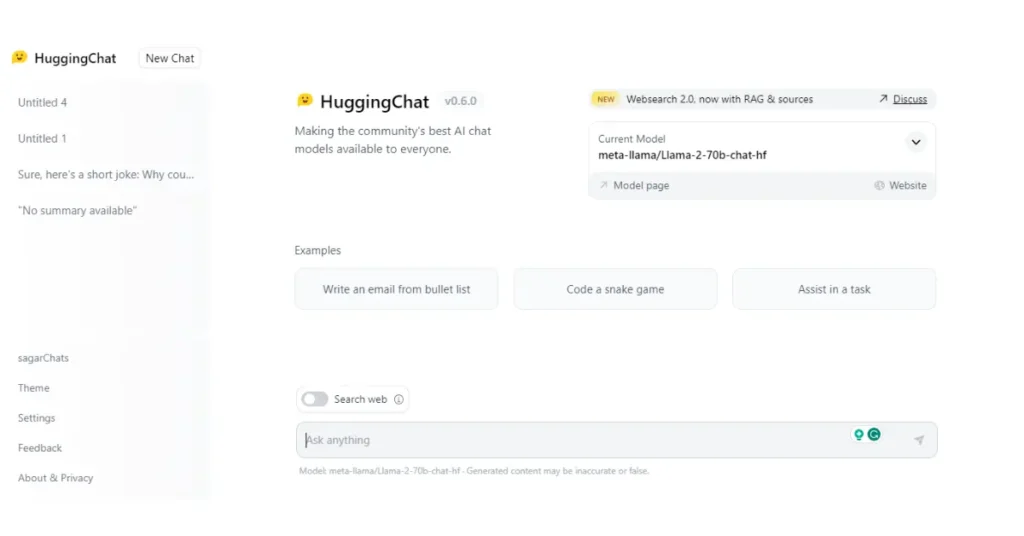
Top Features: Open-Source | Multimodal Capabilities | Extensibility
Another free chatbot that swiftly gained enormous popularity over a couple of months since its release is Hugging Chat. Since day one, Hugging Chat has been compared with ChatGPT due to the overwhelming sameness of the latter. Due to this, Hugging Chat has garnered millions of users to date.
Hugging Chat can write summaries, essays, letters, emails, stories, and whatnot. As far as programming is concerned, Hugging Chat can also code pretty well. It is the only online ai chatbot on our list that is open source. Being an open-source free AI bot, Hugging Chat allows you to access and modify its source code and contribute to its development.
Hugging Chat by Hugging Face also has a web search feature which when enabled, allows the AI chatbot to provide answers based on a live web search. Apart from being able to perform live web searches, Hugging Chat’s own knowledge cut-off surpasses that of ChatGPT. The knowledge cutoff for Hugging Chat is April 2023. However, it is not a hard stop as the online ai chatbot is still able to provide information about a few topics that have been updated since April 2023.
This huge dataset results from worldwide crowdsourcing efforts of more than 13,000 volunteers. The dataset contains 1,61,443 messages distributed across 66,497 conversation trees in 35 languages annotated with 4,61, 292 quality images.
Using Hugging Chat, you can also create a chatbot of your own, fine-tuned according to your personal requirements. You can do so by combining hugging chat with an open-source LLM and training data of open-source datasets.
9. Koala Chat
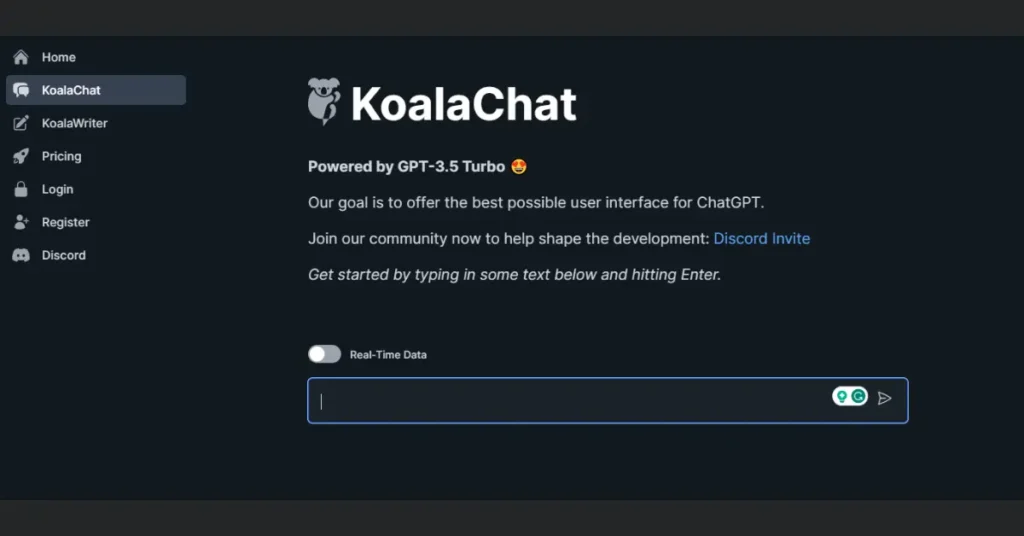
Top Features: GPT 3.5 Turbo | SEO Optimization | Research | Publish Ready Articles | Real Time Data | Can Code
If you are on the lookout for a simple AI chatbot that can deliver results promptly, and do almost everything ChatGPT can but better, head over to Koala Chat. The online ai chatbot is powered by the April 2023 release – GPT 3.5 turbo. Koala works both as a chatbot and an AI writer.
Although Koala Chat uses the same DNA as ChatGPT Plus, it can provide better results with additional functionalities. For example, you can turn on real-time data to get information on the latest subjects along with the necessary citations. It can work as an itinerary generator, can perform basic coding tasks, answer questions, and more.
Interestingly, Koala can perform some unique tasks as well. Koala can also provide links to the websites along with the important pages. For example, we asked it to provide links to all the sections on the NASA website’s home page and it provided us
As said earlier, Koala also works as an AI writing tool. However, calling it just that would be wrong. Koala can work pretty fine when it comes to writing updated content with SEO optimization. Koala almost always writes publish-ready articles and blog posts. The Koala writer is backed up by GPT 3.5 and can be upgraded to GPT 4. The AI chatbot free version is limited to 5,000 words and 25 chat messages. However, at a price of just $9 per month, you can extend the limit to up to 15,000 words and 250 messages alongside features such as: Bulk writing mode, Live Amazon data for affiliate articles, Google Sheets Integration, API Access, and more.
10. Youchat AI

Top Features: Chat-based interaction | Up-to-date info | General question answering | Translation and summarization | Virtual assistant capabilities | Search results integration
You Chat is developed by You.com, an AI search engine. YouChat is created in line with the existing AI search available on You.com. The online ai chatbot uses Open AI’s GPT-3 using which it can perform a set of tasks such as writing, coding, resolving technical queries, calculations, general question answering, and more. Users who earlier visited you.com to look up their queries can now get their answers in a jiffy by just asking the AI Chatbot – YouChat.
Since YouChat is backed up by Google search, you can rely on the AI chatbot for getting the latest and most updated information.
Side by side, You also offers a writing tool – You Write, an AI image generator – You Image, and You Enhance – an AI-based image enhancement tool that can increase the resolution of any image.
How do AI Chatbots Work?
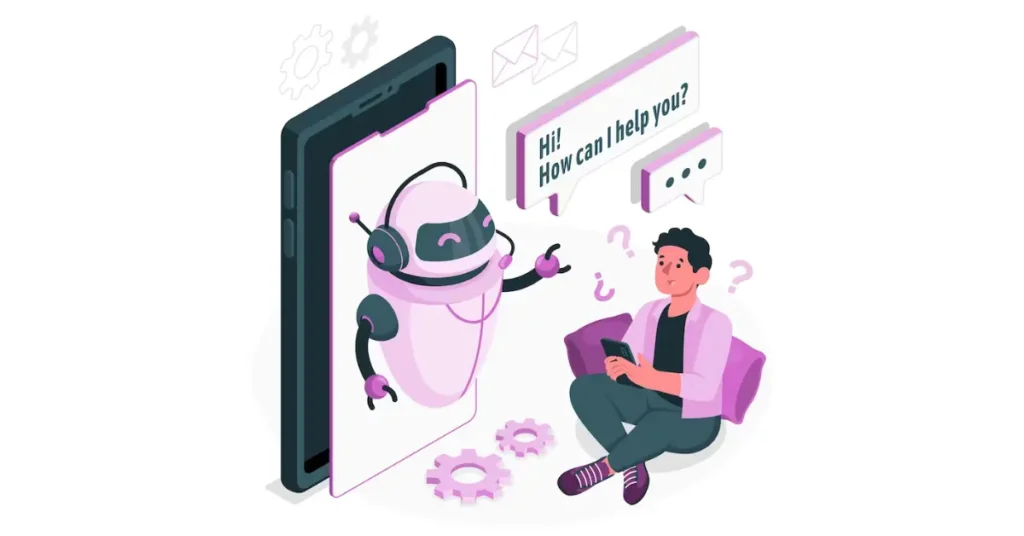
Online artificial intelligence chatbots work primarily on the principle of Natural language understanding (NLU). Following this principle, internet chatbots understand the user’s input and hence, the intent. Upon identifying the intent, a chatbot starts generating the response. Here’s a more elaborate explanation of how AI chatbots work:
Input Processing: In the first stage, the user inputs a message, also known as a prompt for the online ai chatbot to decipher. The prompt can be in the form of a written text or speech.
Natural Language Understanding (NLU): Using natural language understanding, the artificial intelligence chatbot begins to understand the actual meaning behind the user’s query. All AI based chatbots have the ability to decode human languages irrespective of the way they are expressed, whether through text, speech, or a combination of both, enabling seamless communication between humans and machines.
Dialog Management: AI based chatbots are designed to follow a predefined conversation flow. This is known better as a dialog management system (DMS). The basic architecture of most chatbots is divided into two portions: DMS and natural language understanding (NLU). A DMS decides how the chatbot should respond. On the basis of NLU, the online chatbot decodes the user intent. DMS also helps the chatbot handle small talk and greetings to create a more natural interaction.
Information Retrieval: Sometimes, an artificial intelligence chatbot is required to go through the data sets or knowledge bases or in the cases of newer chatbots, perform an actual internet search. This information could include facts, data, or recommendations related to the user’s query.
Response Generation: Once all the information that satisfies the user’s intent is gathered, AI chatbot online provide the response in a natural language. GPT chatbots often excel in this aspect, producing human-like text (natural language generation) that makes interactions with users feel conversational and user-friendly.
User Interaction: Conversation with an AI chatbot is two-way. Upon receiving the response from the chatbot, users can continue asking questions to a conversational AI chatbot if they have any further queries. This back-and-forth interaction continues till the user’s needs are met.
Which AI Chatbot Is Right For You? The Best AI Chatbot
Now that you know a thing or two about the conversational AI chatbots, you should know which one to choose and why:
1. Bing Chatbot: The top all-around AI chatbot, functioning like a search engine, providing real-time info, source links, and user-friendly, all for free.
2. ChatGPT Chatbot: The ultimate chatbot blueprint, covering various skills like writing, coding, and math, and available for public use at no cost.
3. Perplexity Chatbot: Ideal for experimentation and easy interaction, offering prompt suggestions.
4. Jasper Chatbot: Perfect for businesses and marketers, featuring 50+ templates, copyediting, and plagiarism checks, justifying its monthly fee.
5. YouChat Chatbot: A ChatGPT alternative, always accessible, sources from Google, with no cost or capacity blocks.
6. Chatsonic Chatbot: Best for news content creators, providing current news, plus extra features like voice dictation and AI image generation.
7. Google Bard Chatbot: Offers free, tailored writing advice and text generation for essays, resumes, and more.
8. Koala Chatbot: If you want a more versatile and efficient AI chatbot than ChatGPT, Koala Chat, powered by GPT 3.5 turbo, is the ideal choice, offering real-time data, coding tasks, SEO-optimized content creation, and more for just $9 per month.
9. Copy AI Chatbot: Choose Copy AI Chat if you want an all-in-one AI chatbot that excels in blog writing, email campaign generation, and social media content creation, and offers powerful tools for personalization and brand voice preservation.
9. HuggingChat Chatbot: Ideal for those interested in building their chatbot or exploring the process.
Difference Between an AI Chatbot and an AI Writer
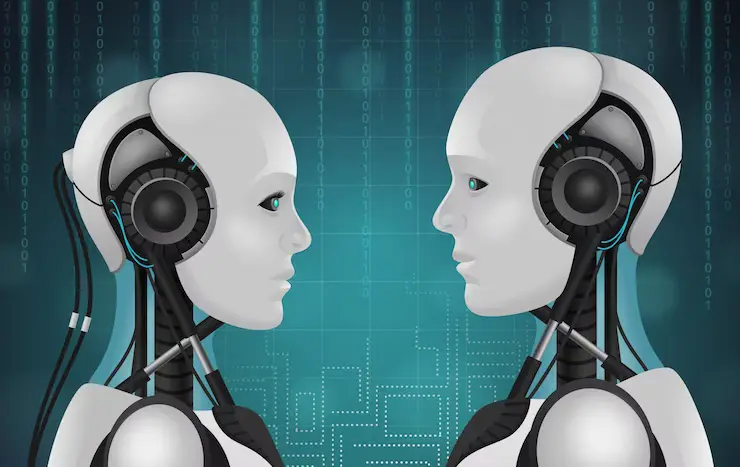
Anyone can fairly get confused between an AI chatbot and an AI writer. Both of these AI applications leverage advanced natural language processing techniques. However, they differ significantly in their use cases and how they engage with the users. Follow the below details to easily understand the key differences between an AI chatbot and an AI writer:
1. Purpose & Function
- AI Chatbot: When you do online chat with AI, you conversate with an AI model designed for the purpose of conversation and interaction. An artificial intelligence online chat happens in a conversational manner to understand and resolve user queries or provide information/assistance.
- AI Writer: On the other hand, an AI writer is a branch of generative AI, focussed entirely on content generation. AI content writers have the capability to write long-drawn-out articles or blogs or short-form content such as product descriptions and marketing copies. AI tools for content writing use natural language generation (NLG) to produce human-like content quickly and efficiently.
2. Interaction
- AI Chatbot: An artificial intelligence chatbot interacts with a user in a two-way conversation. Users enter their prompt/query and receive a response. This conversation can remain ongoing until the user is satisfied with the response of the online ai chatbot.
- AI Writer: An AI writer offers one-way communication, in which the user enters their desired prompt for a specific type of content requirement. Upon receiving the prompt, the AI content writer starts generating the required content. There is often no back-and-forth conversation between the user and the AI.
3. Use Cases
- Artificial Intelligence Chatbot: An online ai chatbot has its uses in customer service, help desks, sales, appointment scheduling, and other scenarios. Basically, all places where a direct human conversation is required.
- AI Content Writers: AI writers have their needs in all kinds of content generation such as blog posts, articles, social media, email marketing, copywriting, and so on. They are mainly used to automate rapid content generation.
4. Technology & Techniques
- AI Chatbot: Artificial intelligence chatbots use natural language understanding techniques to understand the user’s prompts. Many advanced AI chatbots online such as the ones discussed above in this article, also utilize machine learning algorithms for better performance.
- AI Writer: An AI writer on the other hand utilizes natural language generation (NLG) techniques. NLG involves training the AI on large datasets to understand patterns and generate the relevant text.
5. Examples
- AI Chatbot: Some common examples of AI Chatbots are: Siri, Google Assistant, ChatGPT, Jasper AI, Google Bard, and more.
- AI Writer: Some common examples of AI writers are: Copy.AI QuillBot, Rytr, ClickUp, Anyword, Frase, etc.
Benefits of AI Chatbots
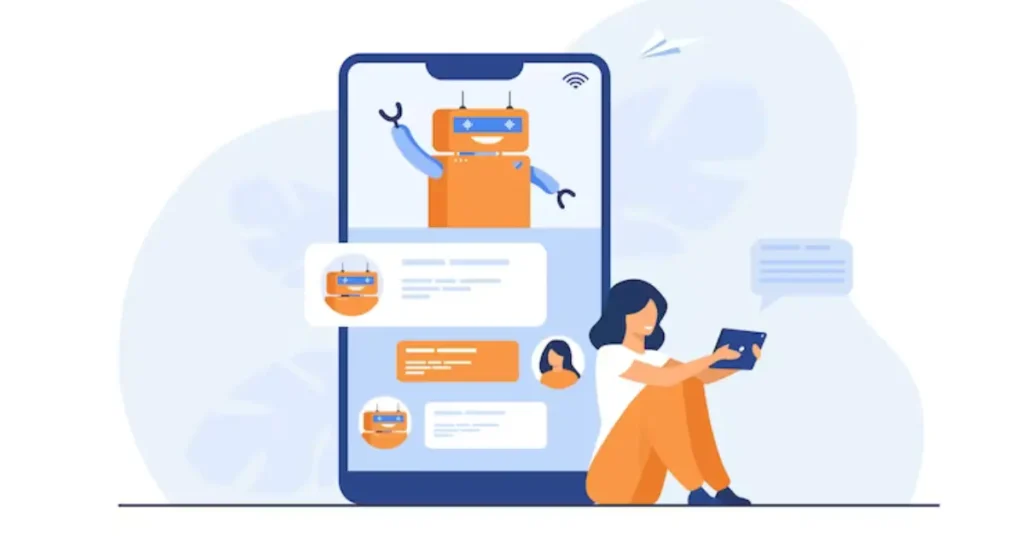
Artificial intelligence chatbots have just about made our lives easier. From scalable content generation to quick coding solutions, AI based chatbots have been a buddy so far. While AI is definitely not perfect and requires human interaction every now and then, there are a ton of benefits of using these online chatbots. Have a look!
- 27/7 Availability: An AI Chatbot is available for the users 24/7. Customers can find help and desired information whenever they want.
- Cost Efficiency: Hiring and training employees burns a hole in the pocket of the employers. Deploying AI chatbots online can lead to significant savings.
- Instant Responses: How long is too long for a customer to wait to get a simple answer? With AI Chatbots, businesses have seen a drastic surge in the number of customer query resolutions as AI immediately resolves queries without making the customers wait.
- Consistency: AI Chatbots perform tasks uniformly and consistently. When customers receive a consistent response from the businesses, the brand value and reputation increase substantially.
- Multilingual Support: Online AI chatbots can offer support in multiple languages. This provides opportunities to businesses for global expansion.
- Increased Productivity: When AI takes over the routine tedious tasks, humans get time to focus more on more complex work responsibilities. By deploying AI chatbots online, humans can shift their complete attention to tasks that require creativity and problem-solving skills.
- Integration: Chatbots can be integrated with other software and systems, including CRM tools, e-commerce platforms, and databases, allowing for seamless data exchange and process automation.
Risks Involved in Using AI Chatbots

Privacy risks and vulnerabilities associated with AI chatbots present significant security concerns for users. It may surprise you, but your friendly chat companions like ChatGPT, Bard, Bing AI, and others can inadvertently expose your personal information online. Hence, it is important to know about the risks associated with the AI chatbot online. Some noteworthy risks of AI Chatbots are as follows:
Risk of Disruption: With artificial intelligence growing at such a rapid rate, it is now very well known to humans that AI is going to take over a big portion of jobs that were once, the bread and butter of many. The change can already be seen in many industries. Even the media and creative industries, which were previously owned by humans are now increasingly incorporating AI-driven tools and algorithms into their processes, challenging the traditional roles of human creativity and decision-making.
As per a March 2023 report from Goldman Sachs, as many as 300 million jobs are at risk and will be eliminated by artificial intelligence technologies like ChatGPT. This number includes 19% of the jobs in the USA itself.
Also Read: Advantages & Disadvantages of Artificial Intelligence
Cybersecurity Risk: Just when the world was beginning to get used to AI technologies like ChatGPT, cybersecurity was going down the drain. The personal and financial data of companies is at the greatest risk due to the advancements in AI technology. The number of cyber-attacks increased by up to 38% in 2022. In the same year, phishing attacks surged to up to 47%.
Major companies like Taskrabbit, Nokia, WordPress, Marriott, and Instagram have already suffered losses due to AI cyber attacks. Criminals are using AI to get inside the safest vaults of the big bulls. We have already seen people tricking ChatGPT into bringing out some extremely dangerous information such as making a bomb or shoplifting. Imagine if a random person could trick AI chatbots online; what could seasoned hackers do?
Operational Risks: Conversational AI chatbots like ChatGPT are an example of the fabulousness of AI. However, just as much as online chatbots are celebrated today, their shortcomings are also being frequently reported. What if a company delegates its operational tasks to AI and it fails? We saw this happening with IBM Watson when it famously proposed incorrect and dangerous treatments for cancer patients. AI chatbots may encounter technical glitches or slow response times which may raise a serious concern for the companies, especially the ones involved in healthcare.
Leaking Sensitive Information: In the month of March, the ChatGPT chatbot experienced a data breach. Because of a bug, users’ personal information such as chat logs and credit card details was exposed. This implies that sensitive information entered into AI chatbot online may be vulnerable to potential leaks. The risk of sensitive information leakage is particularly concerning given the widespread use of tools such as AI chatbot online for marketing or email composition.
Data Poisoning: This one is exactly how it sounds like – poisoning the data for unethical purposes. AI technologies come across as knowledge warehouses because of the enormous training datasets they use to impress users. In many cases, these data sets are open-sourced. Meaning, that they are available for everyone.
Although heavily safeguarded, cyber attackers have a knack for finding loopholes faster than a caffeine-fueled squirrel in a maze full of acorns. Once in, cyber attackers can train the AI or manipulate the data according to their foul intentions. One such example is that of Wikipedia poisoning. A major portion of the AI datasets is extracted from the Wikipedia snapshots. Hackers can find a way to edit the data for their own benefit such as giving a malware-filled link to the users, clicking on which could lead to a cybersecurity breach.
Bias and Discrimination: Even after a billion advancements, AI is still not able to not be biased or discriminatory. Upon the release of GPT-4, it was clearly stated that ChatGPT could still present biased or discriminatory results. A well-known example of this is Amazon’s scrapped hiring bot that exhibited a bias against female applicants. It was later understood that the bot was majorly trained on the resumes of men and hence, it erroneously taught itself that the company only preferred male applicants.
Frequently Asked Questions
Q: Which chatbot is best?
A: Calling one chatbot better than the other would be wrong as each one of them possesses some unique features. However, on the basis of flexibility of doing tasks, ChatGPT chatbot can be called the best free AI chatbots online.
Q: Which chatbot is better than ChatGPT?
A: There are many ChatGPT competitors that have proven their worth as great free chatbots for websites. Some of them include: Jasper AI Chatbot, Google AI Chatbot – Bard, Copy AI chatbot, Chatsonic, etc.
Q: How can I use a chatbot for free in India?
A: There are many chatbots that are either completely free for use or offer a limited amount of features in the free version. You can easily sign-up on any of the internet chatbots listed above on this page and enjoy the free subscription.
Q: What is the disadvantage of an AI chatbot?
A: There are a few disadvantages of AI based chatbots. Some of these risks/disadvantages include: risk of disruption, risk of potential leaks of sensitive information, risks associated with operations, bias and discrimination, etc. You can read more about the risks of AI chatbots above on this page.
Q: Is Alexa a chatbot?
A: Yes! Alexa is a chatbot that comes under the bracket of conversational agents.
Q: Which is the best AI chatbot for coding?
A: GitHub Copilot and Amazon CodeWhisperer are known as the best AI chatbots for coding purposes.
Q: Are AI chatbots capable of handling complex customer queries?
A: Yes, many advanced AI chatbots can handle complex queries by leveraging natural language understanding and context awareness.
Q: How can I choose the right AI chatbot for my business?
A: To choose the right AI chatbot, consider factors like your business goals, budget, required functionalities, and integration capabilities. Test different options to see which one aligns best with your needs.
Q: Which AI chatbot is free?
A: All the artificial intelligence chat bots in the above list either offer a free subscription for either a limited time period or with limited functionalities. Check the complete list from above on this page.
Q: Is Chatbot AI safe?
A: As with the other Artificial technologies, AI chatbots have some risks/disadvantages. Learn more about the risks of AI chatbots from above.

